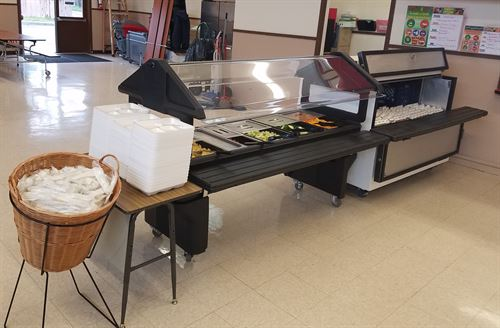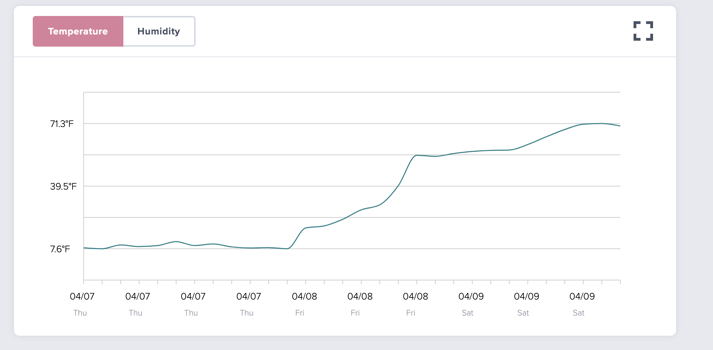GlacierGrid Temperature Monitoring Saves Gridley School District Money

Food inventory disaster averted
We spoke with Scott McMillan, the former School Nutrition Director of Gridley Unified School District (GUSD), to learn more about his experience using GlacierGrid. McMillan’s responsibilities included coordinating the District’s school nutrition program, planning menus that satisfied nutrition requirements for students, and serving as the School Wellness Policy Administrator.
With the help of GlacierGrid sensors identifying a freezer out of temperature range, he caught it just in time to save thousands of dollars worth of food inventory.
Key takeaways
- Using temperature monitoring with GlacierGrid helped GUSD avoid a food inventory loss worth $3,000!

- McMillan appreciated the simple pay-per-sensor subscription model that GlacierGrid offers and the DIY, easy install with no hard wiring or network connections needed
- GUSD’s cooks saved time in the cafeteria with automatically recorded data rather than pen and paper temperature logs
- GlacierGrid’s mobile app provided ease of use for McMillan and GUSD’s cooks by having a view of temperature trends in refrigeration units while at school, or away on holiday breaks
McMillan has since moved on from Gridley Unified School District (GUSD), but was gracious enough to spend time with us discussing his appreciation for GlacierGrid. Read on to see the full contents of our Q&A with McMillan below.
This interview has been edited for brevity and clarity.
Hi Scott, thank you for taking the time today! We really wanted to learn more about your experience in school nutrition. How long have you been in school nutrition?
I’ve been in school nutrition about 20 years.
What does your day-to-day look like as a School Nutrition Director?
We have to create the menus, make sure the food’s stored properly so the kids are safe, and make sure the lines are running smoothly.
What do you like best about the school nutrition field?
Well, I have a passion for kids and making sure they’re taken care of, and I love feeding them so it’s nice to be there for them.
Are there any difficult parts, or things you wish weren’t a part of the job?
For me, I can’t say that there are because I love what I do.
How long did you work for Gridley Unified School District?
I was there for 5 years.
How many sites did you manage?
I managed 5 sites overall, and 4 had food service units.
Were there any other specific incidents that made you want to look for something like GlacierGrid?
We’ve actually lost inventory across 2 different years because the freezer broke down and we had to do the insurance claims and all of that. So I thought, ok, if we had a way to monitor these, we could at least then try to save the food.
What made you decide to go with GlacierGrid?
I really liked the simple payment plan and the fact that there was one price for each sensor. And the sensors were easy to install. GlacierGrid just mailed me everything, it was easy to put them in and get them connected to the base units. And there was no wiring to put in, there was no hard wiring to do—it was wireless. So that was nice.
How has your experience been with GlacierGrid?
It was really good. What I like is that it saves you from having to do the temperature logs because GlacierGrid does all of that for us. And then, like I said [to Tom, Director of Sales at GlacierGrid], the Friday before Spring Break, I got a notification that my freezer temperature was running high, and I was able to go there and find out which freezer was going down.
So I got some help, and we emptied that freezer into another freezer and saved thousands of dollars worth of food. So, just that incident easily paid for GlacierGrid for one or two years.
Can you provide more detail on what happened when you got the GlacierGrid alert?
Well, I was sitting at home, and it was the Friday night before Spring Break. The temperature started rising during the day, but I didn't register it because we received an inventory of trucking and were putting stuff away—I just thought maybe it was taking more time to go down.
But when I got home and started getting alerts, I went on my phone to look at the trend and could see “Wait a minute, it took off right here, and this is when it started going up and never really dropped back down”. That’s when I knew I needed to go back and take care of it. I ran back down there, and it was my freezer where I had what I call my entrée stuff, the meat items like chicken patties, chicken nuggets, pizzas, and hamburgers.
What do you think the value of all the entrées was in that freezer?
I estimated it to be about $3,000.
What would have happened if you didn't have GlacierGrid installed? Would people have been checking on the refrigerators or freezers, or would you have come back after the break to a mess?
If we came back after break and I found all that food, it would’ve been warm… actually, hot, because that was the week when we had 103-degree temperatures. And not only would we have lost the food in there, but we prep our food the day before and what we do before breaks is everything's panned up on racks. And then we put them in the freezer for when we walk in the door so it’s ready to go. So I would have had a big problem.
What does it feel like when a freezer goes down?
Well, all of a sudden, that food is no good and you’re in a panic because somehow you have to go get food because that was what you were going to serve. So now you’re scrambling to try to recover. It’s bad enough we have to lose the money. But the point is, now I don’t have the food that I need to serve to the kids so I also have to scramble at the last minute.
Did you need any need help from anyone on your team to install GlacierGrid, anyone in your IT department?
Before I ordered it, I asked IT and once they heard that the sensors didn't need to be a part of the network, they were fine with it. And if they wanted to, they could’ve connected them because there’s a way to put it on the network. But we didn’t need that at the time.
Outside of avoiding loss events, did you feel like having GlacierGrid added efficiency to your day-to-day?
Yeah, because we didn't have to log it all the time. And then even when we saw there might be a problem, we didn't have to constantly go back and look, we could just look on the app. So we could just look and see what's the trend and go into the detail, see the little graph and know that it was okay.
Did you feel like having the GlacierGrid data helped you with that?
I think it helped us a lot to have the GlacierGrid data in order to see the trends. So if I thought something was going down, I could go online and look. Okay, how long was it? Did it ever go above refrigerator temperatures?
You mentioned going into the app to check temperatures. How often would you use the GlacierGrid dashboard data?
Well, I would go online to check trends but I would really use the app on the phone the most. And then I would get emails saying that my temperature logs were ready so I knew that I could get a month’s worth of data or whatever I wanted. But, a lot of times I used the app the most because it was easy to use. My phone’s always with me, and I had the app on my phone so I could easily go to it.
Did any other team members at Gridley Unified use GlacierGrid?
My head cook had the app on her phone. I didn't have her set up to get the alerts, but she had it on her phone just to check temperatures.
What was your favorite part about GlacierGrid?
I think the alerts are nice. I like the fact that I got texts, so I can go into the app and see what the trend is, and determine if it’s in defrost mode or in a normal range. So I don't necessarily have to react to it at the moment. I could watch it from there to make sure it starts coming back down.
How do you think GlacierGrid changed your day-to-day?
There's more time for my cooks, because when they’d come in for the morning, they’d have to look at the temperature and manually record it on a clipboard. At the end of the day, the same thing.
If you notice it was warm, you might say something but then you'll have to go back and watch it. But with GlacierGrid, it's being checked every 10 minutes automatically. And you can simply look for the blue dot in the mobile app, which means everything is good and I don’t have any issues.
How did that feel for you just being able to check that from your phone?
Well, I felt better knowing that my temperatures were good and I didn't have anything going on. So it made me have a lot less stress because I knew that refrigerators and freezers were fine.
Would you recommend GlacierGrid to any other School Nutrition Directors, or other folks in school nutrition?
Yes, I think schools will definitely benefit from it. Because restaurants, unlike schools, are open year-round. Schools, we close down for a lot of the time during the year like during spring break, winter break and summer break. By having GlacierGrid in there, you know your refrigerators or freezers are still being monitored when you're closed and no one has to go back and check on them.







